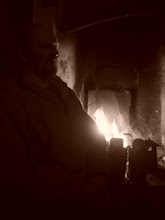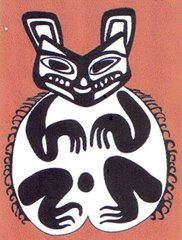Sharpening.
The best set up for sharpening a flat bevel knife involves 2-3 grades of honing stone.
- Course – 800 grit
- Medium – 1000 grit
- Very fine 6000 grit
A very course 250 grit may sometimes be used for restoration work.
At home the best set up for a novice is.
- 2 sided India Oil stone made from Aluminium Oxide. The coarseness is determined by the binding Agent but generally these stones consist of a course and medium side. I often use these to take off secondary bevels and to repair 'dinks' students make in there tools.
Arkansas stones are mined from sedimentary rock in Arkansas (hence the name) and are usually fine and very fine. Arkansas stones are the best naturally occurring stones in the world.
Other useful items –
- Steel, as used by butchers. These are used in the field to produce a micro scopic secondary bevel which gives our edge a more robust finished profile. Be aware a steel does really sharpen your blade it just re-aligns the teeth!
- Strop – leather strop like you see in the barbers shop (or an old leather belt) are used to finish the edge before use and as such remove the microscopic wire created by the sharpening process.
Other products
Japanese Water stones.
- Excellent for producing a superior edge but expensive lacking longevity
- Made from rare clays impregnated with crushed seashells which are ground together and recompressed.
- To use soak in water until the fizzing stops
- Soft will not survive rough handles.
Weston Water stones.
- Basically cheaper copies of the above
- More robust and hard wearing
- Don’t hold so much water.
*note water stones will shatter at below 0 degrees.
Diamond Whetstone
- Rip away a lot of steel very quickly
- Can Ruin your knife fast!
Ceramic stones
- Superheated clays to recreate a volcanic type rock.
- Too hard – take a long time to produce an edge but are good as steels (improvised)
- Expensive
Oil stones
- Robust
- Used will oil
- Very good – a favourite old trooper!
Sharpening Techniques
Field sharpening.
- Cut down water stones or small pocket Arkansas stone
- Sit cross legged and place on shoe to use.
- No ideal system but generally I'd recommend taking the stone to the blade always ensuring fingers are kept clear of the cutting edge!
Base camp sharpening
- Here we use our oil or water stone as follows,
- Place stone on a flat surface
- Lubricate stone (if a water stone soak in water until it stops fizzing the keep wet - never cross lubricate i.e oil on water or vica versa - and for field use always use water as some time or another the only lub' your have handy is spit!) This is to enable the microspoic metal filings to be carried away from the pours on the stone.
- Lay knife flat onto stonestarting at near the handle as possible.
- Tilt up the blade until the bevel is flat on the stone.
- using gentle downward pressure slide the blade (as if slicing of a thin layer) down the stone - starting at the handle but ending the motion at the tip.
- If nec' round the tip slightly to ensure full contact with the stone.
- Do this intially 6 times one one then reverse and do the same towards yourself 6 times.
- Keep repeating this process until were happy the edge is getting sharper.
- Now start to reduce the strokes each side - come down from 6 to 4 to 3 to 2 and then 1
- once on 1 stroke each side to this at least 10 times to weaken the wire (the wire is a very fine strip of metal which builds up as we wear away each side of the blade during sharpening if its not removed it will snap of in use and dull the edge.)
- Once we're happy the edge is sharp we move to the strop - the strop will remove the wire for use.
- Strop in a reverse motion to sharpening - minimum of 50 strokes each way.
Job done test the blade as described.
Stropping – as pointed out above stropping removes the fine wire edge that is built up by the sharpening process. The wire edge makes your knife ‘feel’ sharp but if it is not removed by stropping it will break off in use taking the knife edge with it.
Ideally strop your knife 50 times on each side.
Testing your edge.
Paper test, shave hairs off arm or use thumbnail.
The thumnail test is best - to do this drag your cutting edge across the HARD part of your thumb nail - if your knife is sharp you will feel it biting into the nail - any dull spots will slide without resistance.
Now we have a sharp cutting tool we will look at how to use it SAFELY!!
























No comments:
Post a Comment